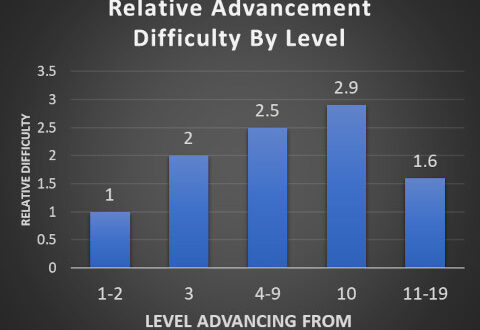Planning for how quickly players gain levels in 5e Dungeons and Dragons is a key element of campaign preparation. Using milestone advancement, the DM can select when and how a party levels up. However, in experience based systems this is generally a matter of the number and difficulties of encounters. Therefore, knowing how quickly players gain levels at different points in the game lets the DM plan better in advance. This means DMs using experience based leveling can anticipate how encounters drive the pace of their campaign.
This started when I asked myself, how many equivalent CR creatures would a player have to face before leveling. Which seems like a straightforward question but becomes complicated when you start to consider party size, CR shifts, or multiple opponents. Some of the charts resulting from those queries are included below, but the takeaway wasn’t terribly helpful. To be sure, how many foes players can expect to face is important for things like treasure or Engaging Players with Magic Item Creation. But the number or even CR of foes isn’t as important as the relative pace of advancing. In other words, how fast to characters level at different points in their lifetime and how does this effect the game?
The Pace of Advancement

Compiling the raw data, it became clear that different groups of levels followed different behavior patterns. The individual groups aren’t as important as what it tells the DM they should be preparing for. That is that, up through 10th level, the pace of leveling either gets more difficult or levels off. This allows players and DMs to adjust to new powers and abilities at a reasonable place. The biggest change comes post 10th level, where difficulty drops to only about 1.6 times that of 1st and 2nd levels.
This means that DMs and players are dealing with new and powerful abilities at a consistently faster rate than any other point in the game. Additionally, at later levels it is very common for parties to face CR encounters much higher than their average level, increasing the pace even more.
Impacts & Considerations
There are few impacts to consider given this realization.
- Campaigns use tier 3 and 4 play the least, so a sudden rise (doubling) in the pace of leveling is likely to catch some DMs off guard.
- You might have misaligned expectations if players used to higher tier play expect milestone to follow a similar pace to experience. This could be as simple a fix as talking about these expectations. But I’ve run so few higher level games, I wouldn’t have known had I not compiled this data.
- When planning for tier 3 and 4 play, get to know those abilities well ahead of time since they’ll come at you fast.
- Include this in considering how the pacing of your game is going to be perceived. Hitting level 3 of a 6 level campaign isn’t half way there, it’s more likely 1/3rd of the way there. Likewise, hitting 10th level of a 20th level campaign is probably closer to 2/3rds of the way there instead of half.
In any case this isn’t earth shattering, it’s just a matter of setting the right expectations. Also, it effects how soon you can expect to bring in elements of different tiers of play into your campaign.
I thought this was worth nothing because I found myself surprised by the relative drop in difficulty at higher tiers of play. I thought it was worth sharing with you as well. Now get out there and run some great games.
Earlier Charts on Advancement Under Different Criteria
Analysis of Advancement Difficulty by Level in 5e